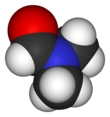
Back Dimetielformamied Afrikaans ثنائي ميثيل فورماميد Arabic دیومتیل فورمامید AZB Dimetilformamida Catalan Dimethylformamid Czech Dimethylformamid Danish Dimethylformamid German Διμεθυλομεθαναμίδιο Greek Dumetil-formiamido Esperanto N,N-dimetilformamida Spanish
 | |||
| |||
| Names | |||
|---|---|---|---|
| Preferred IUPAC name
N,N-Dimethylformamide[1] | |||
| Systematic IUPAC name
N,N-Dimethylmethanamide[2] | |||
| Other names
Dimethylformamide
DMF | |||
| Identifiers | |||
3D model (JSmol)
|
|||
| 605365 | |||
| ChEBI | |||
| ChEMBL | |||
| ChemSpider | |||
| DrugBank | |||
| ECHA InfoCard | 100.000.617 | ||
| EC Number |
| ||
| KEGG | |||
| MeSH | Dimethylformamide | ||
PubChem CID
|
|||
| RTECS number |
| ||
| UNII | |||
| UN number | 2265 | ||
CompTox Dashboard (EPA)
|
|||
| |||
| |||
| Properties | |||
| C3H7NO | |||
| Molar mass | 73.095 g·mol−1 | ||
| Appearance | Colourless liquid | ||
| Odor | Odorless, fishy if impure | ||
| Density | 0.948 g/mL | ||
| Melting point | −61 °C (−78 °F; 212 K) | ||
| Boiling point | 153 °C (307 °F; 426 K) | ||
| Miscible | |||
| log P | −0.829 | ||
| Vapor pressure | 516 Pa | ||
| Acidity (pKa) | −0.3 (for the conjugate acid) (H2O)[3] | ||
| UV-vis (λmax) | 270 nm | ||
| Absorbance | 1.00 | ||
Refractive index (nD)
|
1.4305 (at 20 °C) | ||
| Viscosity | 0.92 mPa·s (at 20 °C) | ||
| Structure | |||
| 3.86 D | |||
| Thermochemistry | |||
Heat capacity (C)
|
146.05 J/(K·mol) | ||
Std enthalpy of
formation (ΔfH⦵298) |
−239.4 ± 1.2 kJ/mol | ||
Std enthalpy of
combustion (ΔcH⦵298) |
−1.9416 ± 0.0012 MJ/mol | ||
| Hazards | |||
| GHS labelling: | |||
  
| |||
| Danger | |||
| H226, H312, H319, H332, H360 | |||
| P280, P305+P351+P338, P308+P313 | |||
| NFPA 704 (fire diamond) | |||
| Flash point | 58 °C (136 °F; 331 K) | ||
| 445 °C (833 °F; 718 K) | |||
| Explosive limits | 2.2–15.2% | ||
Threshold limit value (TLV)
|
30 mg/m3 (TWA) | ||
| Lethal dose or concentration (LD, LC): | |||
LD50 (median dose)
|
| ||
LC50 (median concentration)
|
3092 ppm (mouse, 2 h)[5] | ||
LCLo (lowest published)
|
5000 ppm (rat, 6 h)[5] | ||
| NIOSH (US health exposure limits): | |||
PEL (Permissible)
|
TWA 10 ppm (30 mg/m3) [skin][4] | ||
REL (Recommended)
|
TWA 10 ppm (30 mg/m3) [skin][4] | ||
IDLH (Immediate danger)
|
500 ppm[4] | ||
| Related compounds | |||
Related alkanamides
|
|||
Related compounds
|
|||
Except where otherwise noted, data are given for materials in their standard state (at 25 °C [77 °F], 100 kPa).
| |||
Dimethylformamide, DMF is an organic compound with the chemical formula HCON(CH3)2. Its structure is HC(=O)−N(−CH3)2. Commonly abbreviated as DMF (although this initialism is sometimes used for dimethylfuran, or dimethyl fumarate), this colourless liquid is miscible with water and the majority of organic liquids. DMF is a common solvent for chemical reactions. Dimethylformamide is odorless, but technical-grade or degraded samples often have a fishy smell due to impurity of dimethylamine. Dimethylamine degradation impurities can be removed by sparging samples with an inert gas such as argon or by sonicating the samples under reduced pressure. As its name indicates, it is structurally related to formamide, having two methyl groups in the place of the two hydrogens. DMF is a polar (hydrophilic) aprotic solvent with a high boiling point. It facilitates reactions that follow polar mechanisms, such as SN2 reactions.
- ^ Nomenclature of Organic Chemistry : IUPAC Recommendations and Preferred Names 2013 (Blue Book). Cambridge: The Royal Society of Chemistry. 2014. pp. 841, 844. doi:10.1039/9781849733069-FP001. ISBN 978-0-85404-182-4.
The traditional name 'formamide' is retained for HCO-NH2 and is the preferred IUPAC name. Substitution is permitted on the –NH2 group.
- ^ N,N-Dimethylmethanamide, NIST web thermo tables
- ^ "Hazardous Substances Data Bank (HSDB) - N,N-DIMETHYLFORMAMIDE".
- ^ a b c NIOSH Pocket Guide to Chemical Hazards. "#0226". National Institute for Occupational Safety and Health (NIOSH).
- ^ a b "Dimethylformamide". Immediately Dangerous to Life or Health Concentrations (IDLH). National Institute for Occupational Safety and Health (NIOSH).


